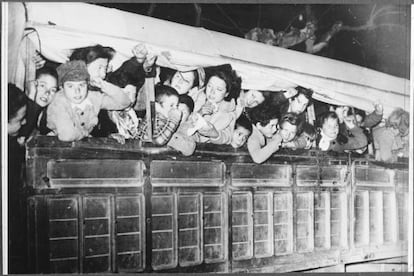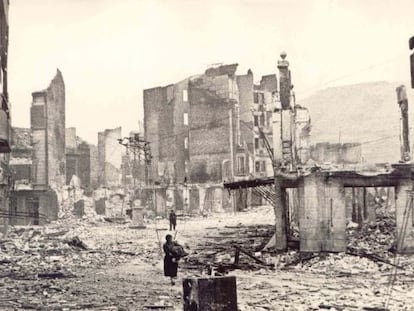The Gernika children who took refuge in Britain
UK government was persuaded by civil society to offer shelter to those fleeing the fascist airstrikes

Herminio Martinez was one week from his eighth birthday when he hitched a lift in the local fishmonger’s van to the docks at Bilbao. There he and his brother would board a ship to England, away from the Nazi bombs raining down on the Basque Country as the Spanish Civil War tore the nation apart.
Three-quarters of a century later, now aged 82, the artist and former teacher sits in the bright studio he built on the back of his cozy north London flat. As commemorative events take place across the Basque country this month to mark a civil war that continues to divide Spain, he talks about the first mass evacuation of children from a war zone in modern Europe as if it was yesterday. In total between 20,000 and 30,000 children were sent away. Thousands went to Belgium and France and many others to the Soviet Union. But some went to Britain.
“I wanted to go to Russia,” says Martinez. “My brother and I were taken down to the docks but the boat was full. So we went back the next day, were given a medical examination and put on La Habana to England.”
Four weeks earlier, fascist leader General Franco, determined to wrest the Basque Country from Republican hands, had called in German and Italian bombers to attack the historic town of Gernika. On April 26 1937, 24 planes carrying 22 tons of explosives destroyed the market town. The attack came to symbolize the atrocity of war and inspired one of Picasso’s most famous paintings, Guernica.
I wanted to go to Russia. We were taken down to the docks but the boat was full"
After the airstrikes, fears mounted for civilians in nearby Bilbao. “We used to see the planes coming over constantly to bomb Bilbao,” recalls Martinez, who lived in the nearby village of El Regato.
The Basque authorities begged foreign governments to offer children temporary asylum. British Prime Minister Stanley Baldwin initially refused, citing a non-intervention pact with other European governments. However, under pressure from the National Joint Committee for Spanish Relief, a group of civil society organizations and MPs from all parties, he caved in.
Martinez’s father, a worker at blast furnaces near Bilbao, accompanied his two sons in the fishmonger’s van. It wasn’t until the boys boarded the ship that the enormity of what was happening hit them.
“I looked out from the deck and saw my father turn around and leave quickly. That’s when I realized he must have been tremendously upset,” Martinez says.
Martinez’s mother, six months pregnant, stayed at home with three other siblings judged too young to flee or old enough to stay and help. It would be 23 years before he saw his parents again. “We were told it would only be for three months,” he remembers.
Chaos onboard the recommissioned cruise liner soon took his mind off the traumatic separation. Designed for 400 passengers, it carried nearly 4,000 children aged five to 16, along with 200 teachers, carers and priests. “Everyone was crying. We were sleeping on the floor and rolling about. We encountered a dreadful storm and everyone was being sick, one girl was screaming to be taken back to her parents.”
Sheer luck determined what their lives would be like; the kids in the Southampton camp went wild"
When they arrived in Southampton, the children were taken to a tented camp in nearby Stoneham. From there they were dispersed to children’s homes, known as “colonies.” Some were fostered to families. It was the first time Britain had dealt with a mass influx of refugees. The government refused to provide financial support, again citing neutrality, even as thousands of young British men and women joined the International Brigades to fight Franco.
The task of feeding and clothing the children fell to local communities. Basque Children’s Committees sprang up in every major UK town. Conservative MP the Duchess of Atholl, a key figure in the evacuation campaign, donated some funding. Adrian Bell, author of Only for Three Months, a book about the evacuees, says the conditions that the children lived in varied from “excellent to bloody dreadful.”
“Sheer luck determined what their lives would be like,” Bell adds. “It was a question of organization and leadership of each particular group running the colonies. Some were penniless. Others, in Cambridge for example, were run by academics and liberals and the children say it was the best time of their lives.”
Their arrival made front-page news. “Initially the coverage was positive,” says Bell. “These were children who were victims of war, of their parents’ war, and it was our duty to look after them.”
But within weeks the mood changed when Bilbao fell to Franco. “Kids in the Southampton camp went pretty wild and the papers ran headlines like ‘Basque children run amok’. They started to call for them to be sent back.”
When Franco took power in 1939 he demanded the children’s return. His officials falsified letters from their parents, many of whom had been killed, were in prison or exile.
Martinez and his brother expected to return home after a letter arrived, apparently from their parents. It took them years to find out why the repatriation never happened. The International Red Cross, having got wise to the falsification of letters, had managed to track down Martinez’s mother.
“She told them she hadn’t written a letter and that she didn’t want us back. She said she wouldn’t be able to cope -- my father was in prison, she had four other children to look after, there was no food and we would starve.”
Around 250 to 400 children were still in the UK when World War II began, and many stayed for the rest of their lives.
“The ones who stayed here have by and large done well,” says Bell. “For those who went back, anything could happen. Some were put in orphanages run by the Catholic Church and treated as the worst of the worst. They had the worst elements of Franco’s regime visited on them.”
Although Franco’s regime ended 40 years ago, Spain is still struggling with its Civil War past. Campaigning former judge Baltasar Garzón was acquitted this year of exceeding his powers to investigate crimes under Franco’s regime. A nun is on trial, accused of stealing babies during and after the dictatorship. Five years ago the Spanish government passed a controversial law to acknowledge and make reparations for Franco-era injustices, reopening old wounds.
Spaniards are divided about how to deal with their recent history. Organizers of commemorative events in the Basque Country this month – such as an exhibition of images by Civil War photographers Robert Capa, David Seymour and Gerda Taro -- are trying to avoid creating a situation between those in favor of revisiting the past and those against.
Historian Dr Olivia Muñoz-Rojas credits international journalists and Picasso for the fact that the bombing of Gernika is being remembered at all.
“Lots of other cities were bombed but Gernika became symbolic because of international media coverage. It was the first time the world saw civilians being killed in the war. Picasso’s painting Guernica was in part inspired by the black and white photos of the bombing and its aftermath.” Without the painting people today might not be talking about the bombing, the evacuation, and their impact, she says.
Martinez remains deeply marked by his experiences. Despite having lived most of his life in the UK, bringing up a family and a long career teaching in London schools, he still feels he doesn’t fit in.
“I still have a feeling of loneliness, of not belonging. When I’m with Spaniards I don’t belong, but when I’m here I’m not integrated into British society either. In other words, I’m a bit of a misfit.”
Tu suscripción se está usando en otro dispositivo
¿Quieres añadir otro usuario a tu suscripción?
Si continúas leyendo en este dispositivo, no se podrá leer en el otro.
FlechaTu suscripción se está usando en otro dispositivo y solo puedes acceder a EL PAÍS desde un dispositivo a la vez.
Si quieres compartir tu cuenta, cambia tu suscripción a la modalidad Premium, así podrás añadir otro usuario. Cada uno accederá con su propia cuenta de email, lo que os permitirá personalizar vuestra experiencia en EL PAÍS.
¿Tienes una suscripción de empresa? Accede aquí para contratar más cuentas.
En el caso de no saber quién está usando tu cuenta, te recomendamos cambiar tu contraseña aquí.
Si decides continuar compartiendo tu cuenta, este mensaje se mostrará en tu dispositivo y en el de la otra persona que está usando tu cuenta de forma indefinida, afectando a tu experiencia de lectura. Puedes consultar aquí los términos y condiciones de la suscripción digital.
More information
Últimas noticias
The complicated life of Francesca Albanese: A rising figure in Italy but barred from every bank by Trump’s sanctions
Half of Scotland is in the hands of 420 property owners
Pinochet’s victims grapple with José Antonio Kast’s rise in Chile
Reinhard Genzel, Nobel laureate in physics: ‘One-minute videos will never give you the truth’
Most viewed
- Pablo Escobar’s hippos: A serious environmental problem, 40 years on
- Why we lost the habit of sleeping in two segments and how that changed our sense of time
- Charles Dubouloz, mountaineering star, retires at 36 with a farewell tour inspired by Walter Bonatti
- Trump’s obsession with putting his name on everything is unprecedented in the United States
- The Florida Keys tourist paradise is besieged by immigration agents: ‘We’ve never seen anything like this’









































